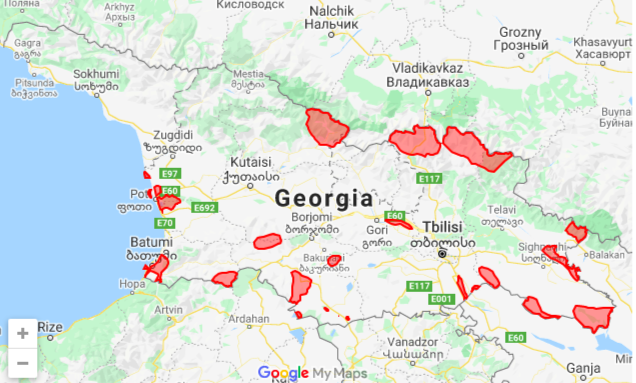Browse by taxonomy
Simple search by name
Male and female Caucasian turs
Taxon: Capra caucasicaAuthor: Zurab Gurielidze
Comment: Svaneti, NW Georgia, autumn 2012
Uploaded by: Kopaliani

Download full size image 1024 X 696
Name According To: https://www.iucnredlist.org/search?query=Capra%20caucasica&searchType=species
Species: caucasica
Taxon Rank: Species
Scientific Name Authorship: Güldenstädt and Pallas, 1783
Vernacular Name: Western Tur (West Caucasian tur)
Georgian Name: დასავლეთკავკასიური ჯიხვი
GBD Remarks:
Conservation Status (International): IUCN status (international) EN A2ad ver 3.1 (Reduction in population size based on an estimated population size reduction of ≥ 50% over the last 10 years, where the reduction or its causes may not have ceased, based on direct observation and actual level of exploitation).
Conservation Status (national): Georgian Red List. IUCN National status (2006) EN A2ad ver 3.1 Pop. trend: decreasing (The species included in the IUCN Red List and reduction in population size based on an estimated population size reduction of ≥ 50% over the last 10 years, where the reduction or its causes may not have ceased, based on direct observation and actual level of exploitation). Prioritized for Action Plan development in the National Biodiversity Strategy and Action Plan for Georgia (2005).
Economic importance (national): interesting as an attraction for eco-tourists and scientists. Under heavy pressure from poaching. Important character of ethnic folclore.
Monitoring methods: Surveys (distance sampling, aerial surveys); camera-trapping; genetic analyses; Habitat suitability modeling. For modelling population numbers with just observational count data from line or point transects, the software to use is DISTANCE (Bukland et al. 2001, Thomas, L., et al. 2010), which is available in Windows-based formats (from http://www.ruwpa.st-and.ac.uk/distanc/). It enables a range of models to be fitted, under a basic detection-function approach.
Contacts and ongoing research activities in Gerorgia: (1) ISU, Institute of Ecology, Institute of Zoology; (2) NACRES. contact – Zura Gurielidze, Natia Kopaliani, Alexander Gavashlelishvili (ILIAUNI), Bejan Lortkipanidze (NACRES). Currently, no ongoing projects. Aerial and land surveys, conducted by the Institute of Ecology at ILIAUNI, were funded by the government in 2012-2013.
Relevant website: http://www.biodiversity-georgia.net; http://www.iucnredlist.org/details/3795/0; http://nacres.org/lmam11.html
Specific relevant information: 2013 land and aerial counts revealed just few mature individuals. Current estimated population size does not exceed 100 individuals, although earlier estimates (http://nacres.org/lmam11.html) suggested presence of ca. 2500 specimens.
Why to monitor: Globally and nationally endangered. Key species in contributing to the formation of mountain ecosystems and an important item of national folklore
Preliminary suggestion: Organize existing data into a user-friendly format freely available on the Internet. Organize annual monitoring at several pre-defined sites in Svaneti, western Georgia, using camera-traps and collecting scats for genetic studies. Monitoring requires two months per year, an expert and 3-4 students.
კონსერვაციული სტატუსი (საერთაშორისო): IUCN სტატუსი საფრთხის წინაშე მყოფი (EN A2ad ver 3.1 - რაოდენობის გამოთვლილი შემცირება 50%-ით უკანასკნელი ათი წლის განმავლობაში, შემცირების მიზეზი დღესაც მოქმედებს)
კონსერვაციული სტატუსი (ეროვნული): საქართველოს წითელი ნუსხა. IUCN ეროვნული სტატუსი (2006) - საფრთხის წინაშე მყოფი (EN A2ad ver 3.1 - რაოდენობის სავარაუდო შემცირება 50%-ით უკანასკნელი ათი წლის განმავლობაში, შემცირების მიზეზი დღესაც მოქმედებს). პრიორიტიზირებულია სამოქმედო გეგმის განვითარებისათვის საქართველოს ბიომრავალფეროვნების სტრატეგია და მოქმედებათა გეგმაში (2005).
ეკონომიკური მნიშვნელობა (ეროვნული):საინტერესო სახეობა ეკოტურისტებისათვის და მეცნიერებისთვის. უკავია მნიშვნელობანი ადგილი ფოლკლორში. ბრაკონიერობის მძიმე ზეწოლის ქვეშაა.
მონიტორინგის მეთოდები: აღრიცხვა (დისტანციური აღრიცხვა, აერო-ფოტო აღრიცხვა); ვიდეო-ხაფანგები, გენეტიკური ანალიზი, ჰაბიტატის მოდელირება. პოპულაციური მოდელირების განხორციელება შესაძლებელია კომპიუტერული პროგრამა DISTANCE (Bukland et al. 2001, Thomas, L., et al. 2010) მეშვეობით. აღნიშნული პროგრამა მუშაობს ვინდოუსის პლათფორმაზე (http://www.ruwpa.st-and.ac.uk/distanc/).
მიმდინარე კვლევები საქართველოში: (1) ილიას სახ. უნივერსიტეტის ეკოლოგიის ინსტიტუტი; (2) არასამთავრობო ორგანიზაცია ნაკრესი. საკონტაქტო პირები - ზურაბ გურიელიძე, ნათია კოპალიანი, ალექსანდრე გავაშელიშვილი (ილიაუნი), ბეჟან ლორთქიფანიძე (ნაკრესი). გრძელვადიანი კვლევითი პროექტები არ მიმდინარეობს. სახელმწიფო დაფინანსებით აღრიცხვა სვანეთში ტარდება 2012-2013-ში.
სასარგებლო ლინქები: http://www.biodiversity-georgia.net; http://www.iucnredlist.org/details/3795/0; http://nacres.org/lmam11.html
სპეციფიკური ინფორმაცია: 2013 წლის აერო-ფოტოგრაფიულმა აღწერამ გამოავლინა სულ რამდენიმე ზრდასრული ინდივიდი. ამჟამინდელი სავარაუდო რაოდენობა არ აღემატება 100 ინდივიდს, თუმცა ადრინდელი შეფასებით რიცხოვნობა 2500 ინდივიდს აღწევდა (http://nacres.org/lmam11.html)
რატომაა საჭირო მონიტორინგი: სახეობა მოწყვლადია ეროვნულ და გლობალურ დონეზე. საკვანძო სახეობაა მაღალმთის ეკოსისტემაში, მნიშვნელოვანი როლი უკავია ეროვნულ ფოლკლორში.
წინადადება: არსებული ინფორმაციის ინტერნეტში განთავსება მომხმარებლისათვის ადვილად აღქმადი ფორმით. ყოველწლიური მობნიტორინგის ორგანიზება რამდენიმე წინასწარ განსაზღვრულ წერტილში, დიდი კავკასიონის ჩრდილოეთ და სამხრეთ ფერდობებზე, საქართველოს არეალის ფარგლებში, ვიდეო-ხაფანგების მეშვეობით და ესკრემენტების შეგროვება გენეტიკური ანალიზისათვის. მონიტორინგისთვის საჭიროა წელიწადში ორი თვე საველე სამუშაო, რომელშიც ერთი ექსპერტი და 3-4 სტუდენტი მიიღებს მონაწილეობას. დამხმარე მეთოდი - პოპულაციის სიმჭირდროვის მოდელირება.
Page Authors: Alexander Gavashelishvili ,
Reference of occurrence in Georgia: Bukhnikashvili, A. & Kandaurov, A., 2002. The annotated list of mammals of Georgia. Proceedings of the Institute of Zoology, Tbilisi, XXI: 319-336
Conservation Status
This section is under construction
National Red List Status of have not been evaluated

